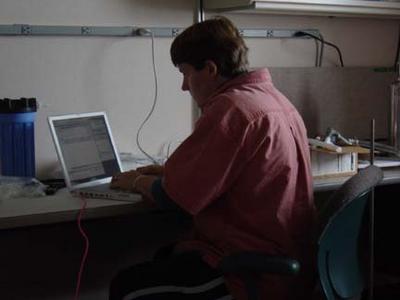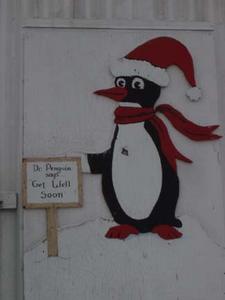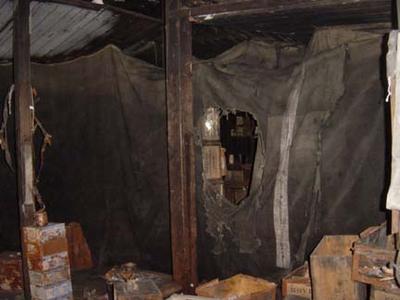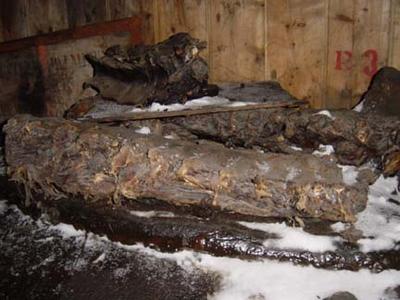7 November, 2004
Ghosts from the past!
Temperature: 8*F
Location: McMurdo Station
We have been working hard to gather all the supplies needed for our trip to the
field camp. We are at a “stand still” at the moment because the things we need
to gather at this point are located in buildings that are closed on Sunday’s.
We took advantage of the delay by getting caught up on email and journal
writing. I must say it was quite nice to have a slower paced day to “catch our
breaths”!
We also took a quick tour of McMurdo station. It’s quite windy here today which
is bringing the temperature, with the wind chill, to below zero. Although we
didn’t want to spend too much time outside, we did want to go for a walk, so we
went through the “check out” procedure. Anytime anyone leaves town, each
person must sign out at the fire station so they can keep track of where
everyone is located. If there were ever an emergency, the rescue teams would
then know where to concentrate their search. We checked out at the fire house
and obtained the key to the Discovery Hut that was built here in McMurdo by
Robert Scott in 1902.
Scott built the hut for his “National Antarctic Expedition”, but since the hut
was difficult to heat, he did not use if for much more than storage. The hut
did, however, get used by several subsequent expeditions. The most use it
received was from the depot laying crew of Shackleton’s famous excursion.
While Shackelton and his ship mates attempted to land on the Weddell Sea in
order to trek cross the continent, his second ship, the Aurora was stationed in
the Ross Sea area. They were laying depots to be used by Shackelton as he came
across the mountains. They used the Discovery hut quite extensively.
Many of the relics from those early days are still in the hut. There are old
biscuits on the shelves, old fuel lamps, and even some old clothes. The
remains of some seals they killed for food and fuel are still heaped on the
floor. It is quite humbling to imagine the hardships the early explorers must
have faced. Being in the hut made me feel as if their ghosts were desperately
trying to convey the struggles they endured.
The hut left us all feeling a bit spoiled by our current conditions! We
returned to the comforts of the modern day McMurdo station. We were able to
get warm, have a cup of hot chocolate, and even take a shower if we wanted. We
got ready to enjoy one of McMurdo’s featured events.
Each Sunday night in McMurdo, a scientist will give a presentation on their
research. This evenings talk was on the Mt. Erebus Bay Weddell Seal Population
Studies. Dr. Robert Garrott explained their most recent findings from their
research. He reviewed the newest techniques and tools they use to determine
the population dynnamics of the seal colonies in the Erebus Bay region. This
seasons seal population is showing a 30 % decrease from previous years. Dr.
Garrott believes this is because there are several huge icebergs just outside
of McMurdo Sound that are blocking the normal exit route for the McMurdo Sound
sea ice. Since the ice can not get out of the sound, it is getting thicker and
more tightly packed. The holes and cracks that weddell seals depend on to
access the surface to rear their pups are not present to the same extent this
year. As a result, there are fewer seals seen. The icebergs are having a
significant impact on the water currents through the sound, thus on nutrient
availability, on all organisms that depend on those nutrients and on the more
typical ice conditions. Ecosystems are dynamic, and this one is fluctuating.

1) Catching up on some e-mail (this photo is for Miss Adams!)

2. The McMurdo doctor reminds everyone to stay healthy!

3. Inside the fire station.

4. Three Happy Campers at the Scott Discovery Hut! (from left: Brandy, Jackie, Robin)

5. Inside the soot filled hut.

6. Old clothes hanging in the hut. They don't look too warm, I'm glad I have all my extreme cold weather clothing!

7. Remains of some Weddell Seals; can you see the vertebrae?

8. An old lantern remains with little left to illuminate.
Contact the TEA in the field at
.
If you cannot connect through your browser, copy the
TEA's e-mail address in the "To:" line of
your favorite e-mail package.
|
